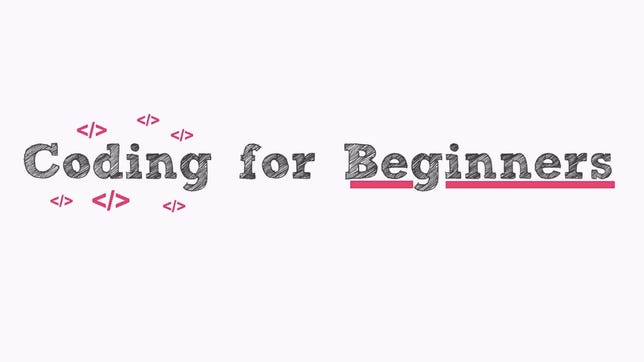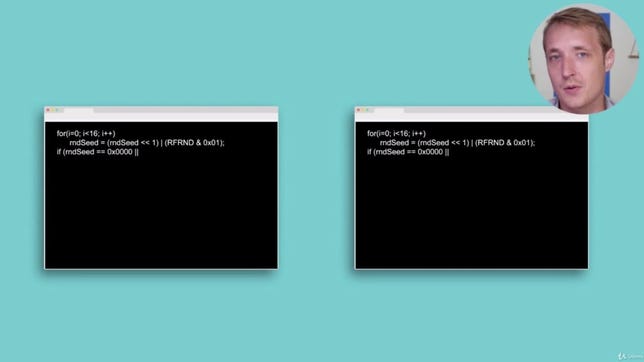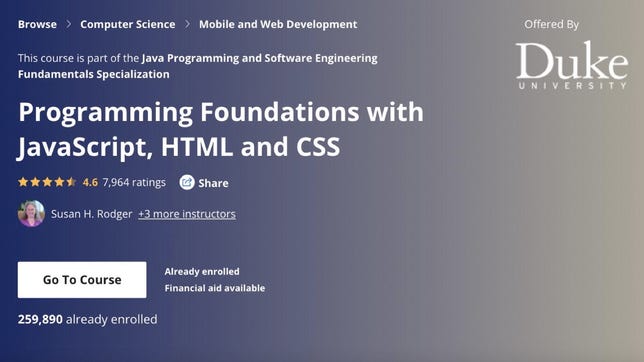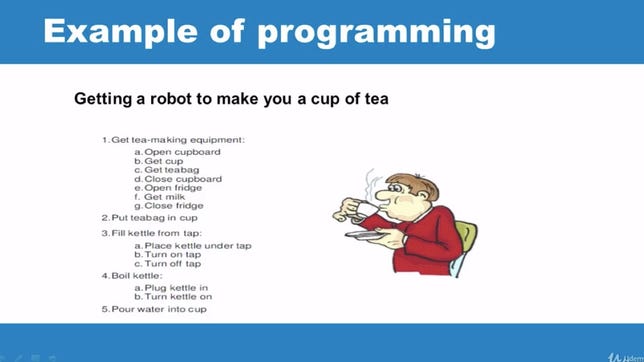Technologies
Learn to Code With These 5 Online Coding Courses for Beginners
Coding skills can unlock new job offers and let you be more creative with projects.

Knowing how to code is a valuable skill, and it can be an easily obtainable one. While I’m not into programming, tinkering with code to build simple websites and apps is an amazing skill. Picking up some coding skills through an online coding course could help you, even if you never considered yourself a web programmer.Plus, demand for software developers remains high across the US.
Before you get started with a online coding class, it’s important to know which language you’ll want to learn — Python, Javascript, C# or one of hundreds of others — hinges on what sort of computer science or data science you want to do with it, like build a website, an app or a game. For example, if you’re interested in learning coding so you can work in a professional setting, you might want to find a coding program that teaches Python, Java or C#, which are all in demand at many companies.
Read more: Want to become a successful YouTuber? Start here
There are a ton of coding classes and beginner courses available on the web, which can help you learn coding skills for whatever piques your interest. We’ve pulled together five beginner-friendly online classes that teach you coding basics and explore the foundational programming concepts and computer programming fundamentals — online coding bootcamp, so to speak. Some touch on specific languages while others stay more general. But no matter which course provider you choose, all of these picks are the best online coding courses to help you get your start learning a programming language. Welcome to coding school, my friends. And I’ll update this list periodically as new coding tutorials become available to help you on your coding journey.
Skillshare/Screenshot by Shelby Brown/CNET
The Coding for Beginners course describes itself as a foundational level course for complete beginners that introduces students to common coding concepts like bugs, pseudo code and how code runs. The concepts can then be applied to whichever programming language you go on to learn. Over 30 lectures and coding lessons will help you build the skillset to build a simple app in both coding languages Scratch and Python, the final project of the course.
What it costs: Some online classes on Skillshare are free when you create an account, but most require a premium membership, which costs $168 annually or $14 a month. You can sign up for seven free days of unlimited classes. The premium membership is also ad-free and lets you download classes to your mobile device and watch offline.
Udemy/Screenshot by Shelby Brown/CNET
Digital agency founder Evan Kimbrell’s preprogramming course also starts with foundational concepts, like how the computer itself, the internet and operating systems fit into programming. This might sound too basic, but if you’re just starting on your learning journey, it’s helpful context.
Eventually, the lesson focus is on the core concepts of coding, different programming languages, front-end and back-end frameworks, application programming interfaces, content management systems and other more advanced concepts.
What it costs: Udemy’s course prices are set by the individual instructors from a price tier, unless they choose to offer them for free. The course is currently on sale for $12.
Skillshare/Screenshot by Shelby Brown/CNET
Software engineer Cas Van Gool’s programming course focuses on the basics of programming found in any software language. The coding tutorials tackle topics like variables, strings, integers, if-statements, while-statements, for-statements and for each-statements. Van Gool provides step-by-step exercises and build projects with C#, from shopping lists to minigames. You’ll also need to download the free Visual Studio Code source code editor program from Microsoft for this course.
This coding class would be useful if you’re interested in coding for games or getting started on a professional level.
What it costs: Some online classes on Skillshare are free when you create an account, but most require a premium membership, which costs $168 annually or $14 a month. You can sign up for seven free days of unlimited classes. The premium membership is also ad-free and lets you download classes to your mobile device and watch offline.
Coursera/Screenshot by Shelby Brown/CNET
The Programming Foundations with Javascript, HTML and CSS course, offered through Duke University, explores skills like HTML, JavaScript, Java programming and Cascading Style Sheets (CSS). You’ll learn how to write programs, solve complex problems, design algorithms, and test and debug your programs.
The programming foundations course is part of the five-course Java Programming and Software Engineering Fundamentals Specialization. You can enroll in a single course to get started and earn a certificate, or audit the online coding class and review the materials for free. The Java Programming and Software Engineering Fundamentals Specialization is considered a beginner specialization, and if you subscribe to one course, you’ll be included in the whole specialization.
The course requires a laptop or desktop computer for Java programming and that you make a free account on CodePen.io. If you choose to continue with the other courses, you’ll need to install Bluej, free software for Java development.
This course would be most useful if you’re interested in coding for websites.
What it costs: Coursera operates more like a traditional online college course with enrollment windows. Sometimes the certificates you earn can apply as a credit at an institution, but it has to be stated. When you sign up for Coursera, you get a seven-day free trial, and then it starts at $49 a month. You can also choose to audit the class for free, which lets you read and view the course content only.
Udemy/Screenshot by Shelby Brown/CNET
Again, what you ultimately want to do with your programming skills will determine what coding language you’ll want to learn. What I liked about the Coding for Beginners course on Udemy is that it touches on the basics of five different programming languages — Javascript, Python, Ruby, HTML and CSS. You’ll get to dabble in each language and build applications like calculators, digital clocks, music players and blog pages. This helps give you a taste of how each operates while also giving you some hands-on experience and projects.
What it costs: Udemy’s course prices are set by the individual instructors from a price tier, unless they choose to offer them for free. This course costs $10 during a special sale.
For more, check out five Masterclass classes to become a filmmaker and other online classes to help you learn to play guitar or learn to draw.
More work-from-home advice
- Google Launches Online Coding Course to Train Workers For Tech Jobs
- Best Resume Builder for 2023
- The Best VPN Services for 2023
- Best Games for Your Work-From-Home Laptop
- Learn Guitar Online: 5 Lessons You Can Take From Home Right Now
- Ultimate Webcam Tips: How to Look and Sound Great Online
- This Is the Gear You Need to Work From Home (And It’s In Stock Now)
- Best Wireless Earbuds and Bluetooth Headphones for Phone Calls
- How to Use Zoom Like a Pro: 19 Video Chat Hacks to Try At Your Next Meeting
Technologies
Sora and Google’s Nano Banana Pro Are Slammed, and Scale Back Free Videos and Images
OpenAI and Google are reducing the number of image or video requests you can make on their latest media-generation platforms.

Maybe it’s because of the holiday weekend.
OpenAI’s video generator Sora and Google’s image generator nano banana pro are placing new limits on how many videos (in the case of Sora) and AI images (in the case of nano banana pro) you can make per day.
With more people using their Thanksgiving weekend idle time to, say, make AI videos of cats as angry service industry cashiers, it’s likely these services are hitting their limits.
Bill Peebles, OpenAI’s head of Sora, posted on X, «our gpus are melting, and we want to let as many people access sora as possible!» GPUs are the graphics processing units used by AI services for the complex computations they need to perform.
Peebles wrote that Sora will limit free video generation to six videos per day. ChatGPT Plus and Pro accounts won’t see any changes.
«And everybody can purchase additional gens as needed,» he wrote.
Don’t miss any of our unbiased tech content and lab-based reviews. Add CNET as a preferred Google source.
Gemini limits
As for Google’s image generator, a Gemini support page says that those without a Google AI plan are now limited to two images generated and edited per day with nano banana pro. The previous limit was three, according to 9to5Google, which also spotted new usage limits on Gemini 3 Pro that are variable. The same support page says free access to Gemini 3 Pro Thinking includes «Basic access — daily limits may change frequently.»
The limit for nano banana (the previous 2.5 non-pro version) is 100 free images per day.
A representative for Google did not immediately respond to a request for comment.
(Disclosure: Ziff Davis, CNET’s parent company, in April filed a lawsuit against OpenAI, alleging it infringed Ziff Davis copyrights in training and operating its AI systems.)
Technologies
If You Don’t Want to Pay AirPod Prices, I Found Great Noise Canceling Earbuds That Are Only $53 for Black Friday
You don’t need to spend a fortune to get a great pair of earbuds.

Black Friday deal alert: If you’re looking for a new pair of noise-canceling earbuds, there are some good deals on Apple AirPods right now, but you might be able to spend half as much to get similar performance. I’ve found that the Air Pro 4 earbuds from Earfun are legitimate contenders to the AirPods, at a much lower price. Right now at Amazon for Black Friday, you can get the Air Pro 4s for a steal — they’re 34% off, which drops their price down to $53.
In short, they’re great, and the black ones are currently available on Amazon for $53, near the lowest price we’ve ever seen them sell for. The other colors are also on sale; the glossy white and royal blue are both $68.
Hey, did you know? CNET Deals texts are free, easy and save you money.
HEADPHONE DEALS OF THE WEEK
-
$248 (save $152)
-
$170 (save $181)
-
$199 (save $150)
How these earbuds silence the noise around you
I prefer in-ear headphones because they offer active, electronic and passive noise cancellation. Passive noise cancellation basically consists of plugging your ears with the rubbery tips included with the earbuds.
The Earfuns fit well for me when I use the second-largest of the five swappable ear tip sizes, and they stay sealed and comfortable for hours. Sometimes I have to reseal one after I yawn or something, but that’s the case with other in-ear headphones, too.
For reading, I prefer Earfun’s «Strong ANC» noise-canceling mode, which makes a big difference when blocking out the noise around you, but there are a bunch of other noise-cancellation options. The Ambient Sound function is good for when I want to pay attention to my surroundings.
Overall, I found the app easier to use than Sony’s and just as capable. The main difference is that Sony’s app has a variable slider for ambient sound.
The Earfun app also includes a white noise section in the app. Normally, I prefer Spotify for white noise (and I download my favorite playlists for offline listening) but this feature is useful for people who don’t have another music service. It includes birdsong, waves and rainfall, all of which are short clips that repeat automatically.
Why I chose these earbuds over AirPods
These headphones have every other feature I’d expect, including the ability to connect to two devices simultaneously and programmable touch-sensitive controls on the buds. Plus, battery life has been more than ample for me, even after a marathon reading session.
There’s also a finder function if you misplace either earbud (unlike Apple FindMy, however, they have to be connected and in Bluetooth range). For actual music and voice calling quality, they sound fine, albeit not as good as my big Sonys.
I have an iPhone and briefly thought about buying Apple AirPods, but I didn’t want to spend the money. The AirPods 4 with noise cancellation cost $115 more than these Earfuns and have an open-ear design, so they rely entirely on the electronic (not passive) method. The AirPods Pro 2 are in-ear and superb, but I didn’t want to spend $250 on a pair of secondary headphones.
Yes, I could probably save some money on an even less expensive pair of in-ear noise-cancelling headphones, but I’m not sure I’d be as happy with their fit, long-term comfort, battery life and noise-cancellation performance. The Earfun Pro 4 buds help me relax and concentrate on my book, and for me that’s priceless.
For more headphone savings, check out our roundup of all the best deals on headphones, or find bargains of all kinds in our roundup of the best Amazon Prime Day deals going on now.
Join Our Daily Deals Text Group!
Get hand-picked deals from CNET shopping experts straight to your phone.
By signing up, you confirm you are 16+ and agree to receive recurring marketing messages at the phone number provided. Consent is not a condition of purchase. Reply STOP to unsubscribe. Msg & data rates may apply. View our Privacy Policy and Terms of Use.
Technologies
I Have a Flashlight Fetish and My Favorite New Olight Is 20% Off for Black Friday
Olight’s sleek new pocket flashlight, the ArkPro, is normally $100. But it’s down to $80 for Black Friday and Cyber Monday.

Truth be told be told, I have a thing for flashlights. Not a bad thing, just a certain appreciation for a well-designed torch, as the Brits might say.
Bright flashlights are good, naturally, but a small, sleekly designed rechargeable everyday carry flashlight that puts out a decent amount of light is high on my list of flashlight favorites, and the new Olight ArkPro and its slightly brighter sibling, the ArkPro Ultra, fit the bill. They’re both on sale for Black Friday and Cyber Monday for 20% off. The ArkPro is down to $80 ($100 list) while the ArkPro Ultra’s price has dipped to $104 ($130 list).
The flashlights are upgraded versions of Olight’s Arkfeld Pro ($70) and Arkfeld Ultra ($84), with higher brightness ratings. Both new models have similar flat, IPX7 waterproof designs with sturdy metal bodies and a magnetic base that allows you to attach the flashlight to anything metal. There’s also an integrated clip-on mount, and they come in cool white and neutral white color temperature versions.
You get three lighting modes: a 1,500-lumen floodlight mode (1,700 lumens for the ArkPro Ultra), an 800-lumen, 205-meter reach spotlight mode (it’s the same for the Ultra) and a UV light mode. You can also activate a green beam laser pointer.
The flashlights come with a wireless charger that magnetically attaches to the base, but you can also charge them via USB-C, which I found more convenient.
I mainly tested the flashlights while walking my dog at night in a pretty remote rural area in New York. The floodlight mode works better for dog walking, but I’d sometimes switch to spotlight mode when I wanted to gauge what was further ahead of us or check whether anything was lurking in the trees or bushes.
These smaller EDC flashlights are well-suited to a variety of activities, including camping and anything you’re doing where you’d like to have a flashlight handy that you can easily carry around in a pocket. You can find similar flat flashlight designs from other brands on Amazon — some of them for significantly less money. However, Olight is considered a premium EDC flashlight brand, though some flashlight enthusiasts are less enthusiastic about the brand for a few reasons. That said, I’m just fine recommending these new ArkPro models when they’re discounted like this. And they do make for nice gifts this time of year.
Join Our Daily Deals Text Group!
Get hand-picked deals from CNET shopping experts straight to your phone.
By signing up, you confirm you are 16+ and agree to receive recurring marketing messages at the phone number provided. Consent is not a condition of purchase. Reply STOP to unsubscribe. Msg & data rates may apply. View our Privacy Policy and Terms of Use.
-

 Technologies3 года ago
Technologies3 года agoTech Companies Need to Be Held Accountable for Security, Experts Say
-

 Technologies3 года ago
Technologies3 года agoBest Handheld Game Console in 2023
-

 Technologies3 года ago
Technologies3 года agoTighten Up Your VR Game With the Best Head Straps for Quest 2
-

 Technologies4 года ago
Technologies4 года agoBlack Friday 2021: The best deals on TVs, headphones, kitchenware, and more
-

 Technologies4 года ago
Technologies4 года agoVerum, Wickr and Threema: next generation secured messengers
-

 Technologies4 года ago
Technologies4 года agoGoogle to require vaccinations as Silicon Valley rethinks return-to-office policies
-

 Technologies4 года ago
Technologies4 года agoOlivia Harlan Dekker for Verum Messenger
-

 Technologies4 года ago
Technologies4 года agoiPhone 13 event: How to watch Apple’s big announcement tomorrow





